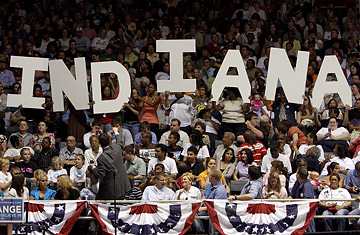
Supporters of Barack Obama attend a rally for the candidate in Evansville, Indiana.
Next Tuesday's primary in Indiana could decide the Democratic nomination: if Hillary Clinton can't combine her post-Pennsylvania momentum and Barack Obama's continuing pastor problems into a red-state victory, her aides concede privately that it would be difficult for her to continue. But polls show the state is still a toss-up, and both sides are focusing on one key battleground — the first Congressional district, which holds 20% to 25% of the likely Democratic primary vote.
The district, in the northwest part of the state, in theory should be Obama's. It's almost entirely in the Chicago media orbit (part of it is actually in the city's metro area) and it has been exposed to Obama's political career as long as any part of the country. It is disproportionately weighted to groups that support him, with 87% of the population urban and 18% of it African-American. The mayor of Gary, the largest city in the district, has endorsed Obama. And various parts of the local Democratic machine are turning it on for him. Clinton's local surrogates just complained that Gary high schools have been using tax dollars to bus voting-aged kids to the polling places for early voting field trips over the last few weeks.
But Clinton is pushing back. In the southern and eastern portions of the district there's a big contingent of blue-collar and union voters. Her famous whiskey shot was taken not in Pennsylvania, but in Crown Point, the seat of the district's populous Lake County, and it targeted the current and former steel and auto workers who still live there. Following a winning tactic from Pennsylvania, she has signed up mayors of seven small to medium-size cities in the district, including the second and third largest ones. Tom McDermott, the mayor of Hammond, says she's been on the phone with him frequently and knows his kids' names. Bill and Hillary Clinton will together make more than four visits to the district before primary day.
The biggest reason for Clinton's competitiveness in the state is her union strength, but she's not impregnable on that score. The top union in Indiana is the United Auto Workers, but it previosuly backed Edwards in in its region #3, which covers Indiana and Kentucky, so the union is now officially neutral. And while the state's UAW chief has appeared with Clinton at events, Obama has managed to poach his number two, Connie Thurman, who is the wife of the long-time region #3 UAW boss Terry Thurman. Most importantly, Obama has ensured that the union isn't officially organizing for either side.
Of all the neutral players in the state, though, the most coveted is the congressional representative from the first district, Pete Visclosky. He sits on pots of money thanks to his appropriations subcommittee chairmanship, and has an unmatched get-out-the-vote team that he built for himself from scratch. Obama's team has been pressing hard for help, but Visclosky is staying studiously neutral. "Both campaigns would relish the opportunity to be able to stand beside Pete Visclosky in the first district," says Clinton state chair Joe Hogsett, "but he's staying true to his pledge to stay neutral."
The excitement is high, as reflected in the ballots already returned in the region. Lake County is close to doubling its 2004 early voting totals with a week still to go. So far more than 7,800 ballots have been cast there, compared with a total early vote of 4,053 in the 2004 Democratic primary and 2,822 in the 2000 one.
